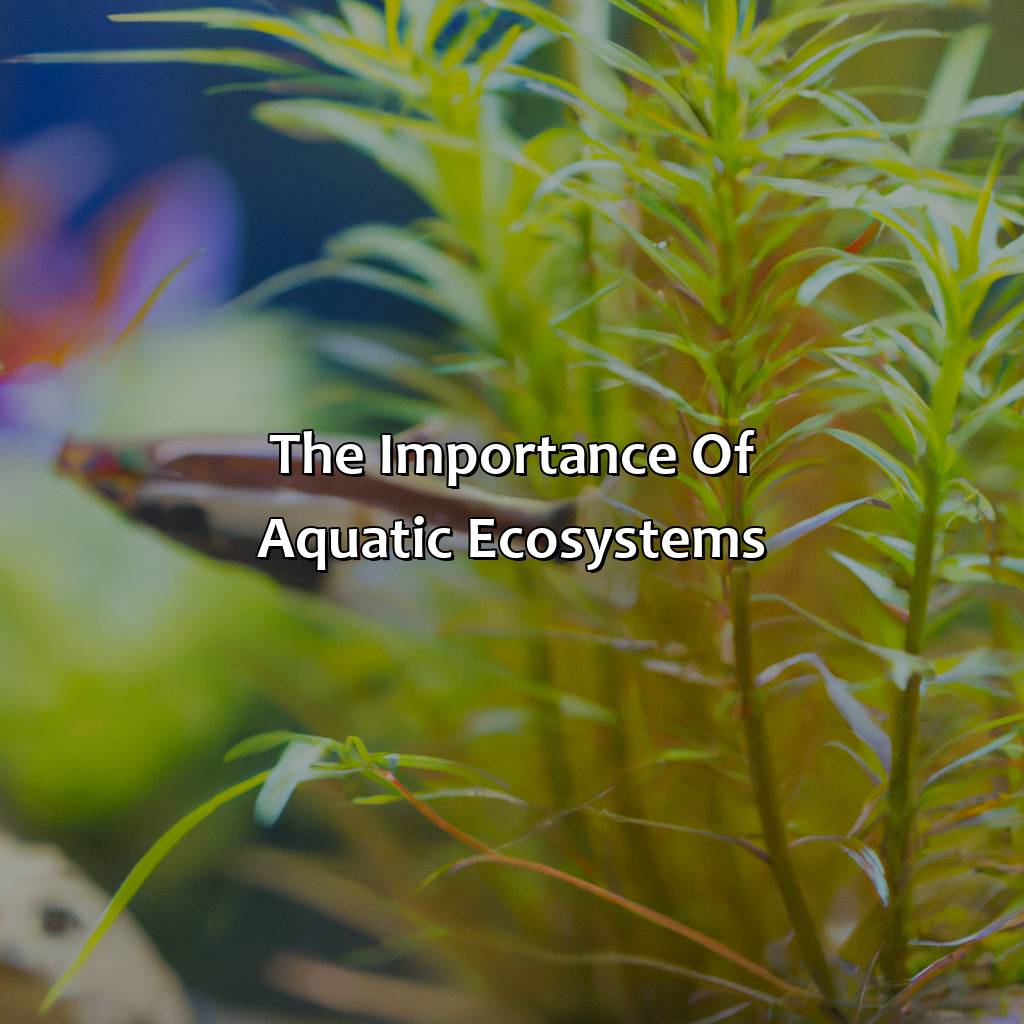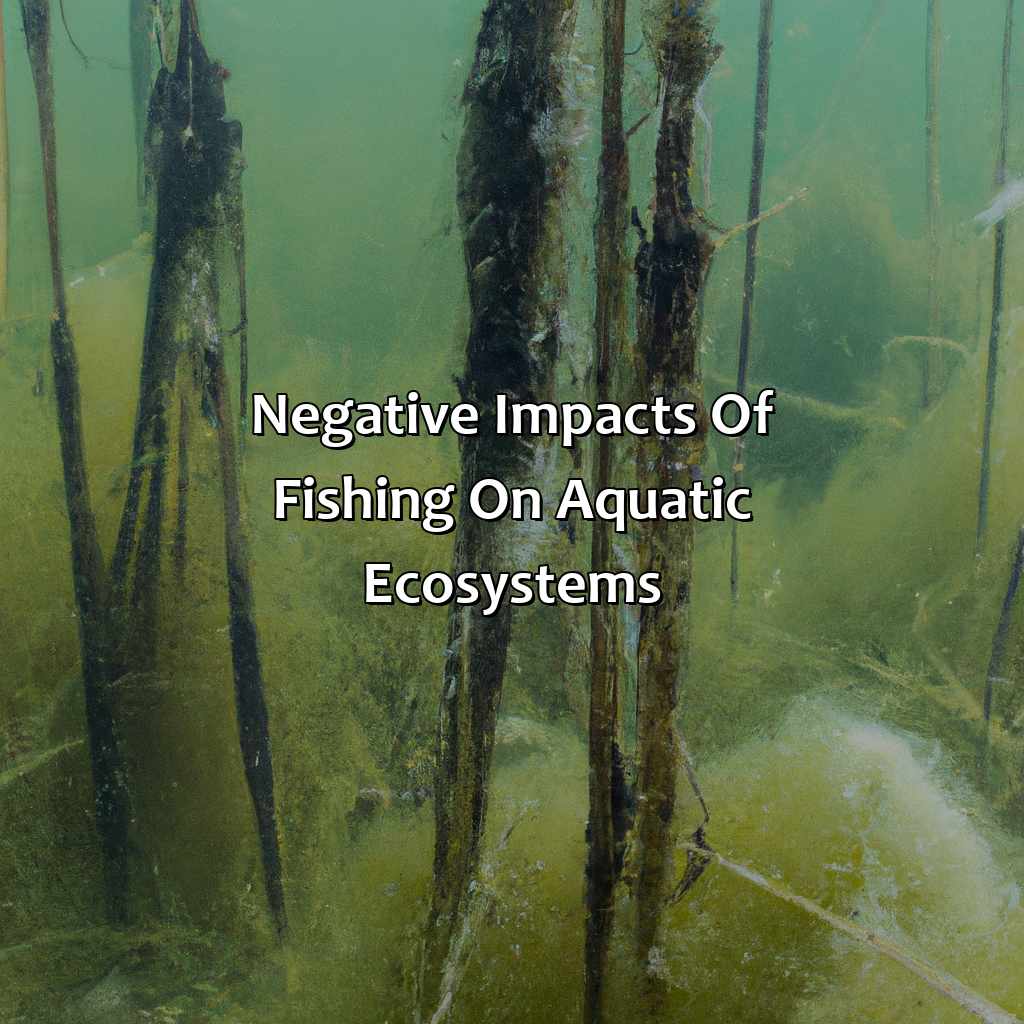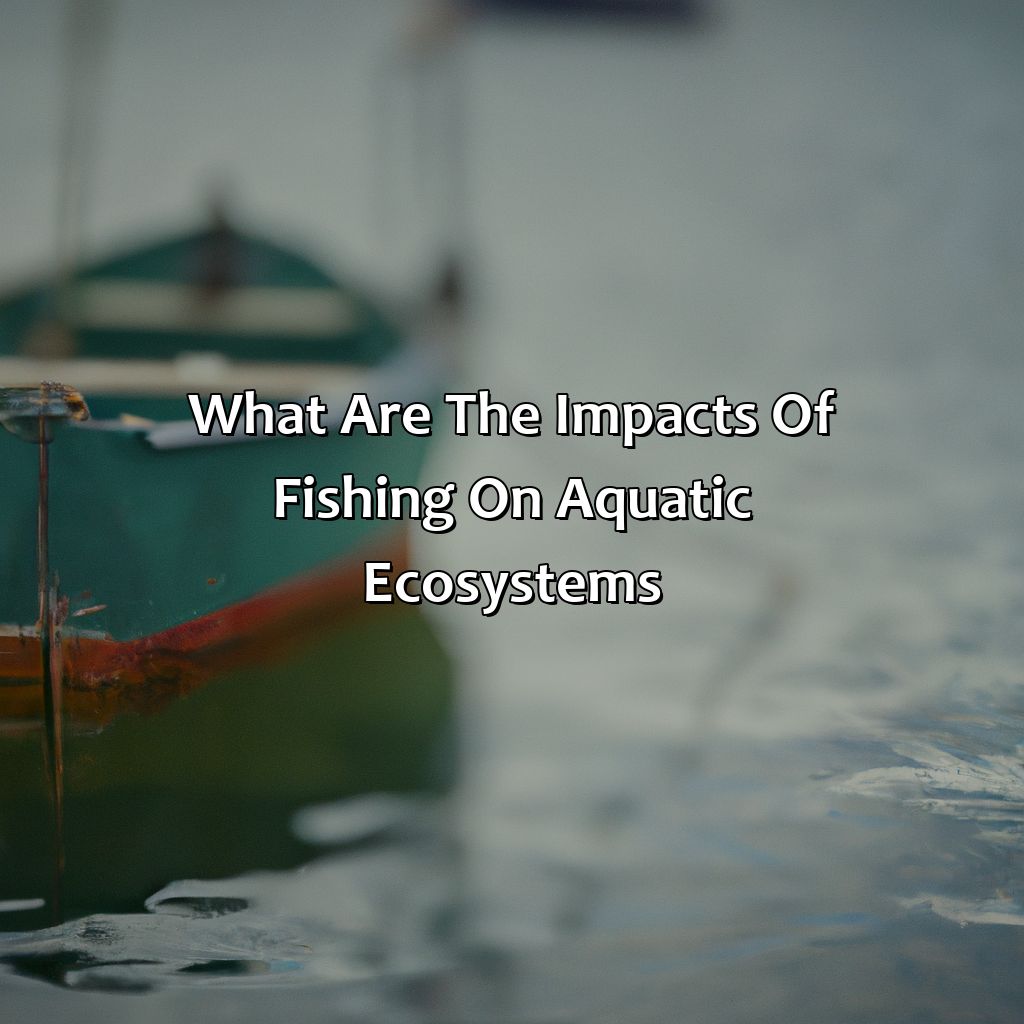Key takeaways:
- Fishing has negative impacts on aquatic ecosystems, including biodiversity loss and ecosystem services.
- The negative impacts of fishing on aquatic ecosystems include overfishing, bycatch and unintentional capture of non-target species, and habitat destruction and alteration.
- The positive impacts of fishing on aquatic ecosystems include sustainable fishing practices and conservation efforts that promote ecosystem health and biodiversity.
The importance of aquatic ecosystems

Photo Credits: anglinginsight.com by Lawrence Martinez
Aquatic ecosystems are vital for the survival of many living organisms, including humans. These ecosystems provide a wide range of crucial ecosystem services, including water purification, nutrient cycling, and temperature regulation. The biodiversity of aquatic ecosystems is also significant, with a countless range of species, many of which are still undiscovered.
Human activities such as fishing have a significant impact on aquatic ecosystems. Overfishing can lead to a decline in fish populations, which can have an adverse effect on the ecosystem and its services. This biodiversity loss can impact human communities that depend on fishing resources. Furthermore, fishing practices such as trawling can damage the habitat, leading to physical damage to the ecosystem.
Another factor that affects aquatic ecosystems is climate change. The rise in temperatures can modify the chemistry and physical features of the water, which can reduce the number and diversity of species following fishes. These changes can also affect the quality of the services provided by aquatic ecosystems, leading to negative consequences for humans.
According to the World Wildlife Fund, overfishing, and destructive fishing practices affect over a billion people worldwide, highlighting the importance of protecting these ecosystems. It is evident that maintaining aquatic biodiversity and the health of its ecosystems is crucial for the survival of humans and the natural world.
Negative impacts of fishing on aquatic ecosystems

Photo Credits: anglinginsight.com by Carl Sanchez
To grasp the effects of fishing on aquatic ecosystems, you need to look at the issues and dilemmas. Overfishing and diminishing of fish populations are caused by impacts, fish stocks, and fishery subsidies. Fishing gear can lead to unintentional capture of non-target species, such as marine mammals, sea turtles, sharks, and stingrays – this is known as bycatch. In addition, fishing techniques can cause destruction and alteration of habitats, such as coral reefs, seagrass beds, wetlands, mangroves, estuaries, freshwater ecosystems, rivers, lakes, dams, and hydroelectric power.
Overfishing and depletion of fish populations
The unsustainable fishing practices have caused a decline in fish stocks worldwide. The consequences of overfishing and the depletion of fish populations extend beyond marine life, affecting the ecosystem, human food supply and even economies heavily reliant on fishery subsidies. Harmful practices include commercial fishing techniques that exploit immature and juvenile fish, implementing large scale fishing techniques or practicing open-access fisheries.
A significant factor contributing to the depletion of fish populations is overfishing, which refers to catching more fish than can meet the replenishment rate. This action results in a decrease in the overall population size and genetic diversity leading to smaller-sized fish with fewer breeding adults; thus, creating a downward spiral for the species. Fish population declines can be attributed to weak management policies that allow excessive or unregulated fishing practices.
Despite global overfishing concerns, some countries still subsidize their fishing industries, which exacerbates unsustainable fishing practices by creating an artificial incentive for more significant exploitation pressures within vulnerable stocks. To combat this accelerating problem, adopting sustainable models such as reducing unintentional catches of unwanted species increase survival rates and remaining resources make progress toward sustainability goals achievable.
Studies show that between 1970 and 2012, marine populations dropped by half due to factors such as pollution and unsound fishing habits resulting from careless or aggressive behavior towards aquatic ecology.
Looks like fishing isn’t just a bummer for fish, but also for marine mammals, sea turtles, sharks, and stingrays who get caught up in the mix as bycatch.
Bycatch and unintentional capture of non-target species
Unforeseen bycatch is an imbalance in commercial fishing practices. It leads to the capture of non-target species like marine mammals, sea turtles, sharks, and stingrays caught inadvertently while aiming for a particular fish species. The problem is further exacerbated by the type of fishing gear used, where methods like bottom trawling disrupt seabed habitats and prove destructive for non-target species’ survival.
This unintentional catch or waste is a critical threat to aquatic biodiversity, causing millions of deaths annually. A study by the food and agricultural organization (FAO) says that approximately 10-20% of global catches are discarded as bycatch every year.
Furthermore, since some economic benefits can be found in later use following the impact on target fish populations when conservation measures regarding bycatch are implemented, there are potential improvements in reducing unwanted incidental catch rates through modified forms of gear technology and strict localized fishing restrictions being enforced.
Fishing techniques have turned coral reefs, seagrass beds, wetlands, mangroves, estuaries, rivers, lakes, dams, and hydroelectric power areas into unrecognizable habitats.
Habitat destruction and alteration
The destruction and alteration of aquatic habitats due to fishing techniques is a significant concern. It impacts crucial ecosystems such as coral reefs, seagrass beds, wetlands, mangroves, estuaries, freshwater ecosystems including rivers, lakes, dams and hydroelectric power facilities. The impact ranges from direct physical damage caused by gear such as trawling nets to release of catastrophic amounts of sediment during bottom dredging. These damages can cause immense harm to sensitive habitats like estuaries that serve as critical breeding areas for various fish species.
Furthermore, indiscriminate fishing also causes damage to non-targeted species disrupting the delicate ecological balance. Habitat damage and alteration lead to the loss of biodiversity and negatively impacts wild populations’ recruitment processes through straining their habitat’s carrying capacity limits. Moreover, overfishing’s ripple effects on local communities who depend on the aquatic ecosystem for survival can be distressing.
To prevent or lessen these harmful effects, policymakers have set regulatory frameworks that emphasize habitat preservation and restoration while optimizing sustainable fishing practices in line with scientific data on population dynamics. This includes a focus on establishing data-driven management plans with explicit goals targeting specific species populations or entire aquatic ecosystems’ sustainability levels.
Sustainable fishing practices aren’t just good for fish stocks, they also pave the way for eco-tourism, promote cultural heritage, and empower communities through knowledge transfer and citizen science.
Positive impacts of fishing on aquatic ecosystems

Photo Credits: anglinginsight.com by Tyler Adams
To understand how fishing can be a positive influence on aquatic ecosystems, let’s explore sustainable fishing practices and conservation efforts. Also, we’ll examine ways to promote ecosystem health and biodiversity. This includes:
- fishery management
- eco-tourism
- fish stocks
- wildlife trade
- subsistence and indigenous fishing
- cultural heritage
- knowledge transfer
- community-based conservation
- citizen science
- environmental education
- interdisciplinary research
- policy framework
- public awareness
- intergenerational equity
Sustainable fishing practices and conservation efforts
Fishing can have a significant impact on aquatic ecosystems and their sustainability. One way to mitigate this impact is through the use of sustainable fishing practices and conservation efforts that promote long-term ecological health and stability. This involves developing and implementing fishery management plans that are designed to protect fish populations, reduce bycatch and unintentional capture of non-target species, and minimize habitat destruction and alteration caused by fishing gear.
Sustainable fishing practices also involve supporting artisanal and traditional fishing practices that are less harmful to the environment than industrial fishing methods. This includes using more environmentally-friendly fishing gear, such as traps or lines instead of nets, or promoting the use of closed containment systems for fish farming. It also requires careful management of fish feed to avoid overuse of antibiotics in aquaculture, which can contribute to the spread of fish diseases.
Conservation efforts must also address issues related to aquatic invasive species that can enter new ecosystems through ballast water or be intentionally introduced for aquaculture purposes. Other concerns include managing water demand while avoiding pollution from sewage, nutrients, pesticides, herbicides, metal contamination, plastic pollution (including microplastics and nanoplastics) and ghost fishing gear left behind by abandoned equipment. In addition, efforts should be made to reduce waste by recycling unused byproducts created during processing.
Without sustainable fishing practices and conservation efforts, we run the risk of damaging fragile aquatic ecosystems irreparably. It is essential that we take steps now to ensure the long-term health and vitality of our marine environments – both for ourselves and for future generations who depend on these resources for their livelihoods.
Want to promote ecosystem health and biodiversity? Hook, line, and sinker, sustainable fishing practices can positively impact aquatic ecosystems from coral reefs to freshwater rivers.
Promoting ecosystem health and biodiversity
Fishing, when done sustainably, can promote the health and biodiversity of aquatic ecosystems. By practicing responsible fishing techniques, fish populations may be restored and the effects of overfishing may be reversed. Additionally, fishing operations can help maintain the complex trophic cascade within aquatic ecosystems by keeping populations of apex predators in check.
Certain types of fishing practices, such as recreational and small-scale fishing, can also provide economic opportunities for local communities while preserving the environment. For example, sustainable tourism based on recreational fishing can benefit coral reefs, seagrass beds, wetlands and mangroves.
Fishing operations can even have positive impacts on freshwater ecosystems such as rivers, lakes and dams. Commercial fisheries managed under sustainable guidelines have shown to help maintain healthy wetland habitats and preserve their ecosystem services. Hydroelectric power generation from dammed rivers can also be balanced with responsible management practices that allow for sufficient water flow for fish migration.
Unfortunately, not all fishing practices are environmentally friendly. However unsustainable or destructive methods such as bottom trawling or dynamite fishing have long-term negative impacts on marine habitats by damaging fragile coral reefs and seagrass beds.
Five Facts About the Impacts of Fishing on Aquatic Ecosystems:
- ✅ Overfishing can lead to the depletion of fish populations and disrupt food webs in aquatic ecosystems. (Source: National Geographic)
- ✅ Bycatch, or unintentionally catching non-target species, can harm marine mammals, sea turtles, and other aquatic life. (Source: NOAA Fisheries)
- ✅ Bottom trawling, a common fishing method, can damage seafloor habitats and disrupt ecosystem functioning. (Source: MarineBio)
- ✅ Overfishing and destructive fishing practices can also impact the livelihoods and food security of local fishing communities. (Source: World Wildlife Fund)
- ✅ Sustainable fishing practices, such as using selective gear and establishing marine protected areas, can help mitigate the negative impacts of fishing on aquatic ecosystems. (Source: Marine Stewardship Council)
FAQs about What Are The Impacts Of Fishing On Aquatic Ecosystems?
What are the impacts of fishing on aquatic ecosystems?
Fishing has both positive and negative impacts on aquatic ecosystems. Some of the negative impacts include overfishing, bycatch, habitat destruction, and nutrient enrichment. However, fishing can also benefit ecosystems through the removal of invasive species and the creation of artificial reefs.
What is overfishing?
Overfishing occurs when more fish are removed from a body of water than can be reproduced, leading to decreases in fish populations and potentially causing imbalances in the ecosystem. Overfishing can also reduce genetic diversity and change the structure of the food web.
What is bycatch?
Bycatch is the unintentional capture of non-target species during fishing activities. This can include turtles, dolphins, birds, and other marine life that become entangled in fishing gear or caught in nets. Bycatch can have negative impacts on the health and survival of these species and can disrupt the balance of the ecosystem.
How does fishing impact habitat destruction?
Fishing practices such as trawling and dredging can cause significant damage to aquatic habitats, including the destruction of coral reefs, seagrass beds, and other important ecosystems. This can have wide-ranging impacts on other species in the ecosystem that rely on these habitats for food and shelter.
What is nutrient enrichment, and how does it impact aquatic ecosystems?
Excessive nutrient inputs from fishing activities, such as discarded bait and fish waste, can cause nutrient enrichment in aquatic ecosystems. This can lead to harmful algal blooms, oxygen depletion, and changes in water chemistry, which can negatively impact the health of fish populations and other species in the ecosystem.
What can be done to minimize the negative impacts of fishing on aquatic ecosystems?
Several measures can be taken to minimize the negative impacts of fishing on aquatic ecosystems, including implementing sustainable fishing practices, reducing bycatch, protecting critical habitats, and promoting responsible fishing practices among fishermen and communities that rely on fishing for their livelihoods.

